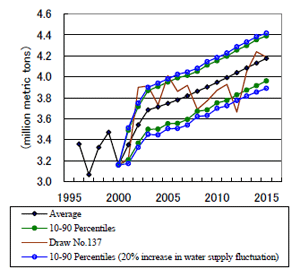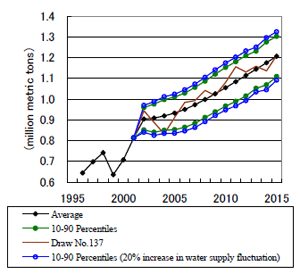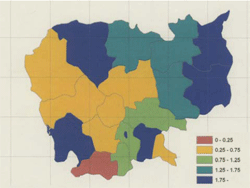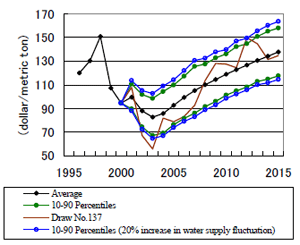Impacts of water cycle changes on the rice market in Cambodia
Description
Water is an indispensable input for agricultural production and the supply is highly influenced by hydrological cycle changes. Climatic changes caused by global warming leads to the activation of the water cycle and these probably expand water supply fluctuations. The changes will affect the supply and demand of crops. Therefore, econometric analyses related to the cycle changes are important to aid in the design of agricultural policies and plans.
Farmers, who are in developing countries where the unit share of irrigated fields is low, are at risk of severe damage by global hydrological changes. Simulation results of the supply and demand model considering water cycle changes for each region will provide important information for formulating policies to offset or mitigate the negative consequences. Cambodia is one of the world’s poorest countries, and the percentage of the population with below US$1 purchasing power parity was 34% in 2003. Rice consists of 68.5% of the food consumption; hence the industry related to the supply of rice is quite important for the economic development of this country.
This study tries to clarify the impacts of water supply changes on producers and consumers of rice in Cambodia using a supply and demand model of rice which takes into consideration the hydrological cycle changes. The developed model is extended to a stochastic model and fluctuations of water supplies are analyzed. The difference between the 90th and 10th percentiles for wet season rice production is about 400 thousand metric tons, which is about 10% of the average seasonal production (Fig.1). On the other hand, that for dry season rice production is about 180 thousand metric tons, which is about 17% of the average production (Fig.2). Therefore, the variation in production during the dry season is relatively greater than that in the wet season.
To investigate the expanding water supply variability, a simulation in the case of increasing 20% of the random water supply was conducted. The difference between the 90th and 10th percentiles for wet season rice expanded into 500 thousand metric tons (Fig.1) and that for dry season rice expanded into 220 thousand metric tons (Fig.2). The percentage increases of these changes, relative to the productions in the base year are 2.5% and 3.8% respectively, indicating that rice production during the dry season is more affected by water supply changes than during the wet season.
Impacts of water supply changes on the planted areas during the wet season were investigated. Planted areas in regions where elevations are high, such as Rottana Kiri, Mondol Kiri, and Koh Kong, and the lands vulnerable to flooding, such as Phnom Penh and Prey Veng, are sensitive to increased fluctuations in water supplies (Fig.3).
Finally, the variations in the farm prices were investigated. The distribution of prices is slightly negatively skewed; the width between 90th percentile and the mean is $19.27 per metric ton and that of between 10th percentile and the mean is $18.71 per metric ton for the baseline (Fig.4) (Farm prices are calculated using the exchange rate in 2002: US$1=3912.1 Riels). The asymmetry of the distribution is based on the logarithmic ET variables of yield and planted area functions, and it corresponds to the diminishing planted area in the case of water supply scarcity. If the water supply expands 20%, the average width between the 10th and 90th percentiles of simulated outcomes for farm prices will increase from $38.09 to $45.50 (Fig.4). The upper price band is larger than the lower band suggesting that the situation of low income consumers could grow worse under an unstable environment with relatively larger upward price spikes.
Figure, table
-
Fig. 1. Fluctuation in the production of wet season rice for the whole country -
Fig. 2. Fluctuation in the production of dry season rice for the whole country -
Note: Numbers are coefficients of variations in the case of a 20% increase in water supply fluctuations from the baselines.
Fig. 3. Fluctuations of planted areas during wet season -
Fig. 4. Fluctuation of farm prices
- Affiliation
-
Development Research Division
- Classification
-
Technical A
- Term of research
-
FY2007(FY2003~2007、FY2006~2010)
- Responsible researcher
-
FURUYA Jun ( Development Research Division )
YAMAMOTO Yukiyo ( Development Research Division )
SUZUKI Kenji ( Development Research Division )
KOBAYASHI Shintaro ( Development Research Division )
- ほか
- Publication, etc.
-
Furuya, J. and S. D.Meyer. (2007): Impacts of water supply changes on the rice market in Cambodia: Development of a supply and model of rice considering water supply changes. Journal of Rural Economics, Vol.79, No.1, 1-15. (written in Japanese)
Furuya J., Meyer D.S. (2008): Impacts of water cycle changes on the rice market in Cambodia: stochastic supply and demand model analysis. Paddy and Water Environment Vol.6, pp139-151.
- Japanese PDF
-
2007_seikajouhou_A4_ja_Part2.pdf466.65 KB




